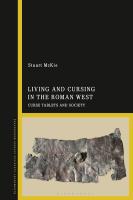
Bloomsbury (2022) h/b 285pp £81 (ISBN 9781350102996)
M. is an Associate Lecturer at the Open University and an Honorary Fellow in the Dept. of Classics and Ancient History at Durham University. He specialises in Roman social history and particularly in religious or magical issues. This book, in the Bloomsbury Classical Monograph series, is his first individual publication.
He examines the practice, common throughout the Roman Empire and at most periods, of an individual declaring an anathema against another individual or individuals by writing about it on a tablet (of various material) and then, with ceremony, depositing the tablet deliberately in a place where the anathema was deemed more likely to be potent. His study is based on 607 tablets found in 127 different locations in the western empire that are reasonably dateable to the first five centuries AD. The language used in the tablets is usually Latin but Greek and Celtic are also found.
In the first substantive chapter he describes the distribution and spread of this corpus and the religious environment in which they were produced. He is anxious to insist that the tablets should be seen through a prism of ‘lived religion’ (i.e. how individuals experienced their religious activities) rather than through that of an official system with top down rites. In the next chapter he describes the ways in which the tablets were produced and subsequently deposited and in the next the reasons why the tablets were produced. In the final chapter he examines what the depositor of the tablet hoped to achieve. This analysis is supported by 90 pages listing over 110 examples of the corpus (with place of origin, estimated date, text and translation) and by a further 40 pages of notes and bibliography.
His examination discloses the huge variety of the corpus, almost to the point of defeating any but the simplest taxonomy. The archaeology usually defies dating and tends to preserve non-degradable material, particularly lead. Wooden or wax tablets were probably also used but have not survived. The tablets identify a name or names to be cursed, normally by wishing upon the cursed some malevolent outcome. There seems to have been little political animosity involved and most of the cursers (and the cursed) appear to be ordinary citizens, including occasionally slaves. Most of the curses were individually authored, although in some situations you could probably acquire a template with appropriate gaps for the names. Some tablets are lengthy and elaborately phrased but many are brief and barely literate. The competence of the handwriting varies widely as does the layout. There appear to have been several common reasons for producing the tablets—revenge for property that has been stolen from you, influencing the outcome of chariot races, influencing the outcome of upcoming court cases or luring a woman into your bed by making her feel uncomfortable in her present situation. There is a similar variety in the malevolent outcome sought by the curser. Statistical examination suggests that curses involving thefts were popular in Britain while curses to obtain a competitive result were popular in Africa and Rome, but some of these observations may well be due to the places in which significant numbers of tablets have been discovered, e.g. the hot springs in Bath or the hippodrome in Carthage. Naming was clearly a crucial element in the process and is occasionally used as guidance for whither the gods might direct their attentions. Similarly the place of the deposit was important and the curser had to believe that the place chosen would by itself increase the potency of the curse.
The strength of M.’s analysis is his reluctance to engage in more detailed taxonomy and his insistence that each example needs to be examined sui generis. He offers a range of alternative explanations to most problems and, by providing a lot of source material, enables readers to make their own choices. Ultimately no one can know why an anonymous curser decided to deposit a curse tablet, what they hoped to achieve by the deposit nor to what extent they believed that it did or would work. M. has also powerfully advanced his preference for examining this sort of material in terms of ‘lived religion’. His style is reasonably jargon free and for the general reader offers a stimulating insight into the lives of ordinary citizens which will be new to them. At £80 it is however perhaps a bit pricey for that group.
Roger Barnes
